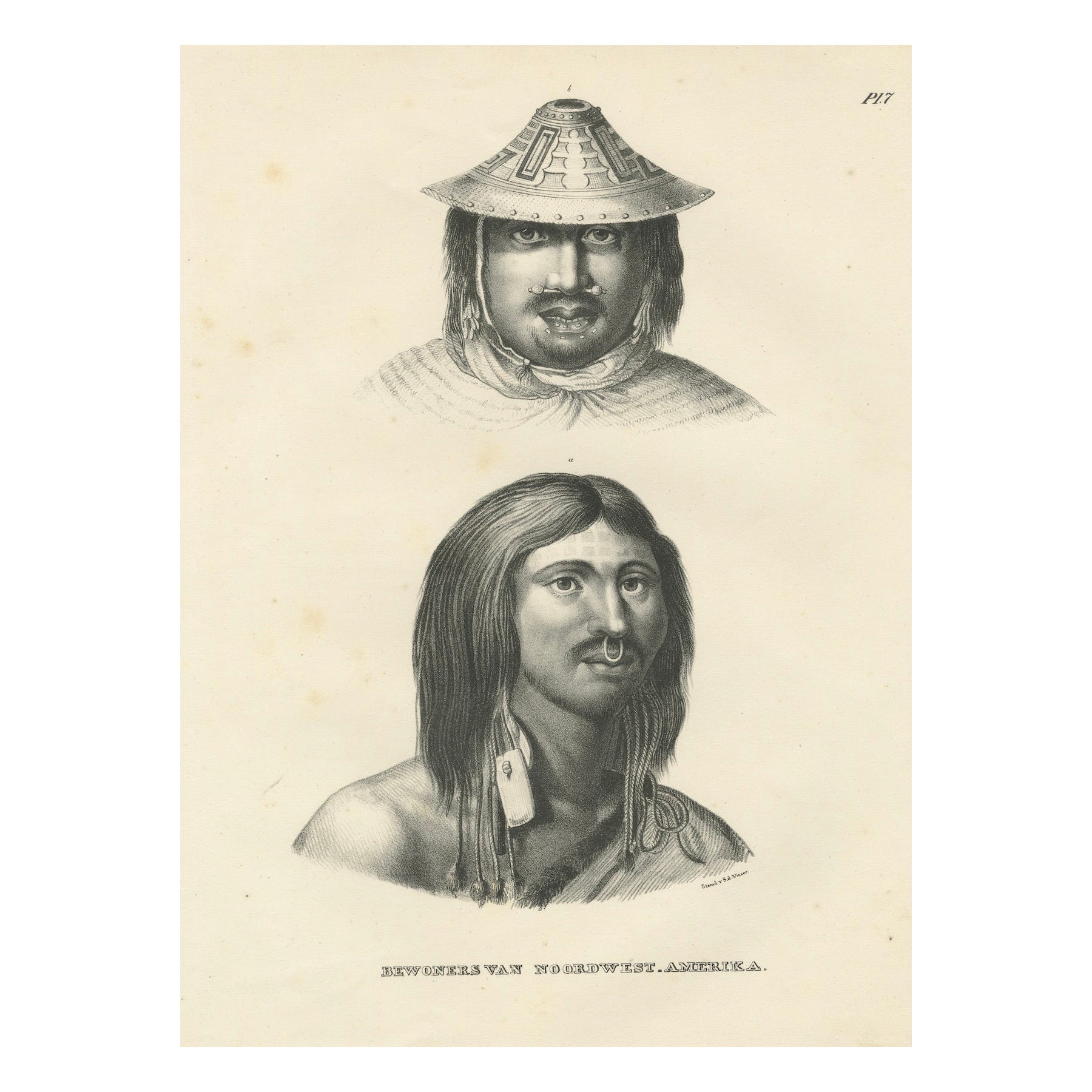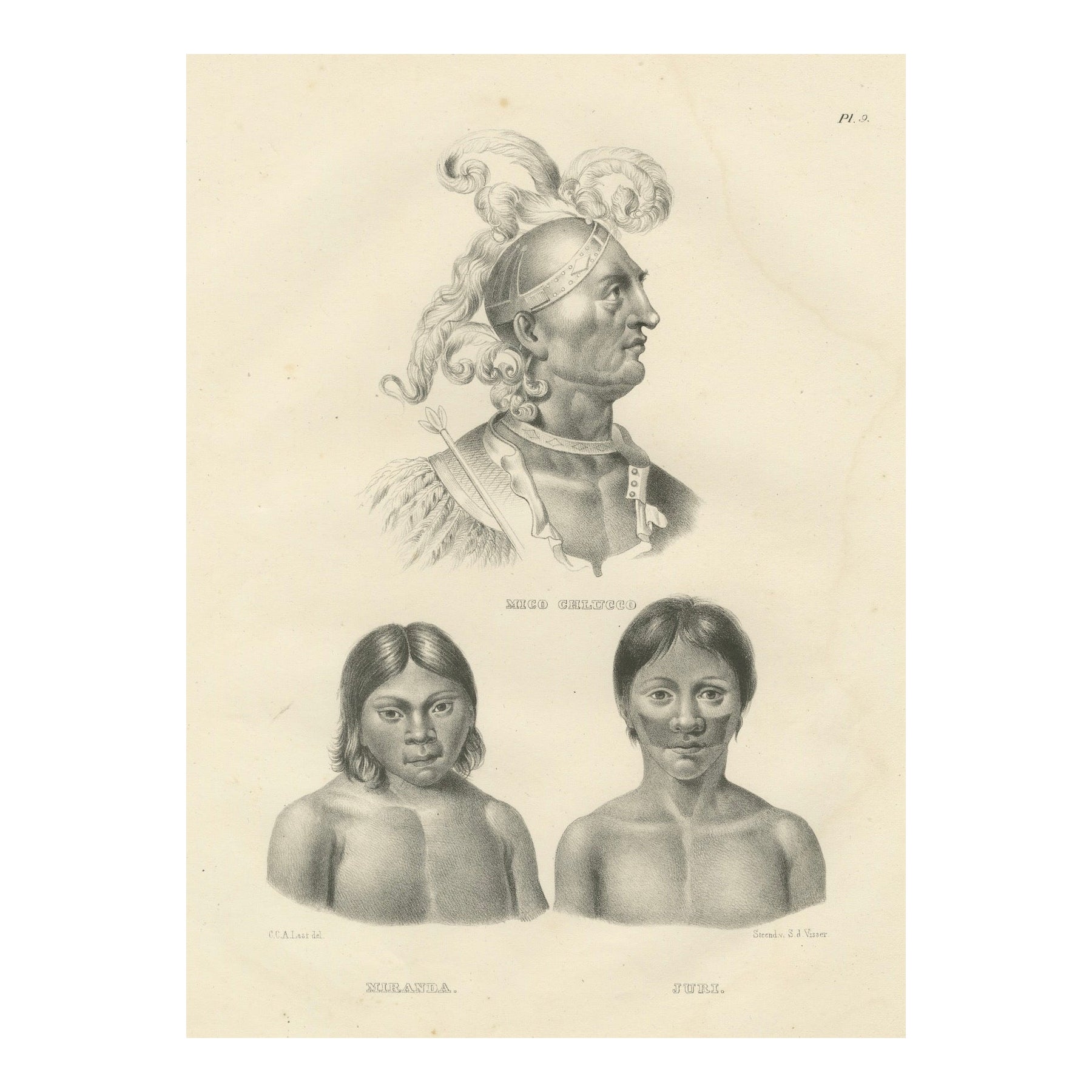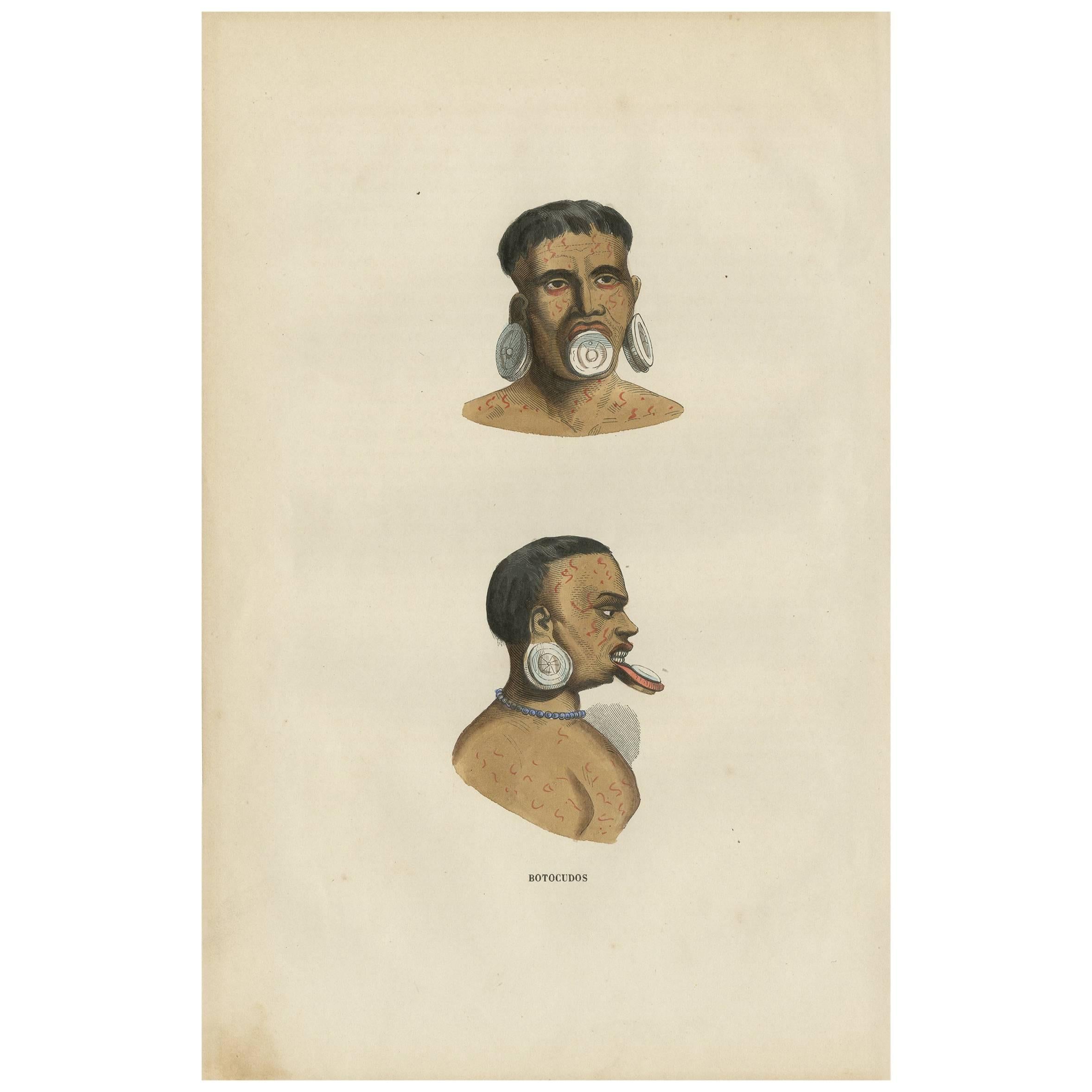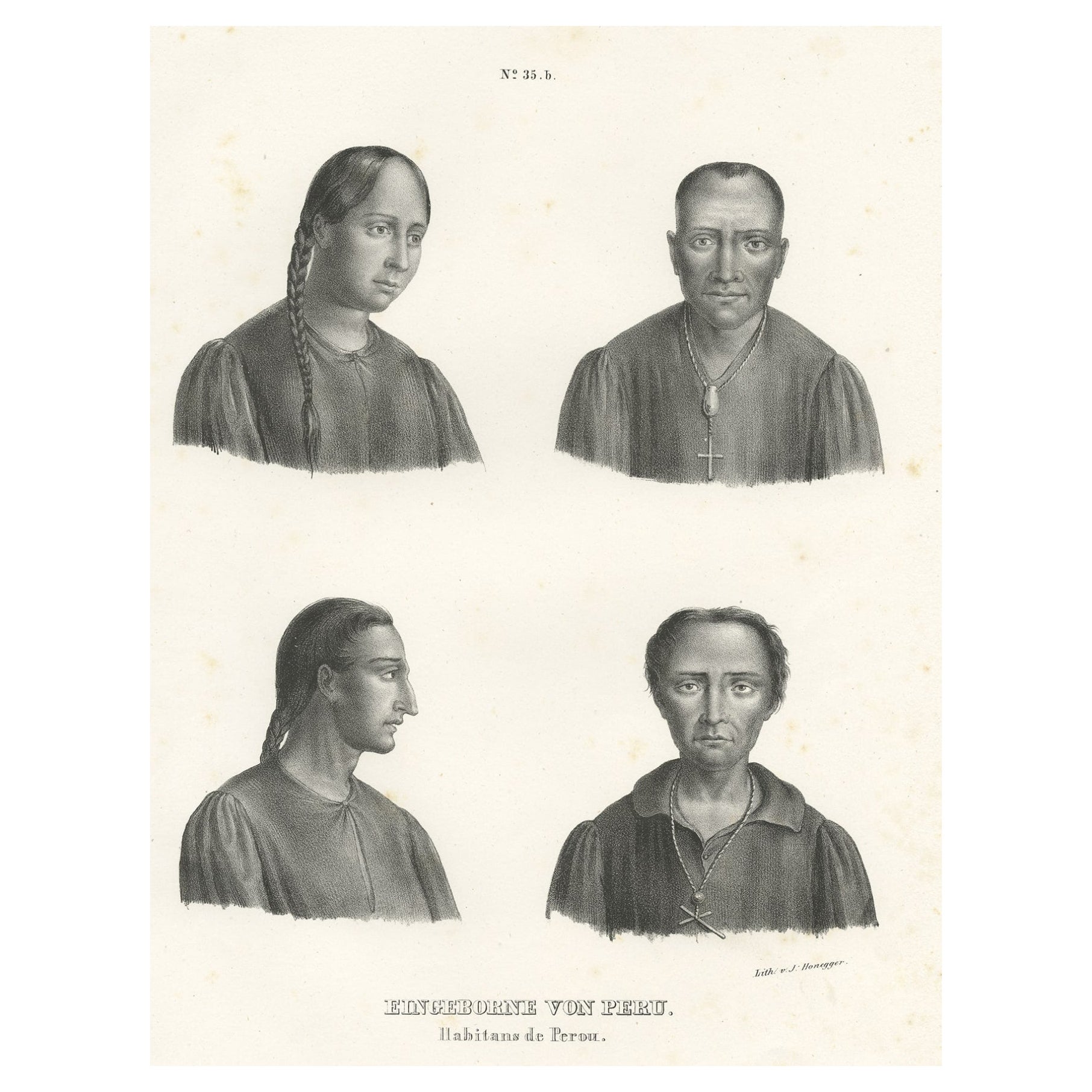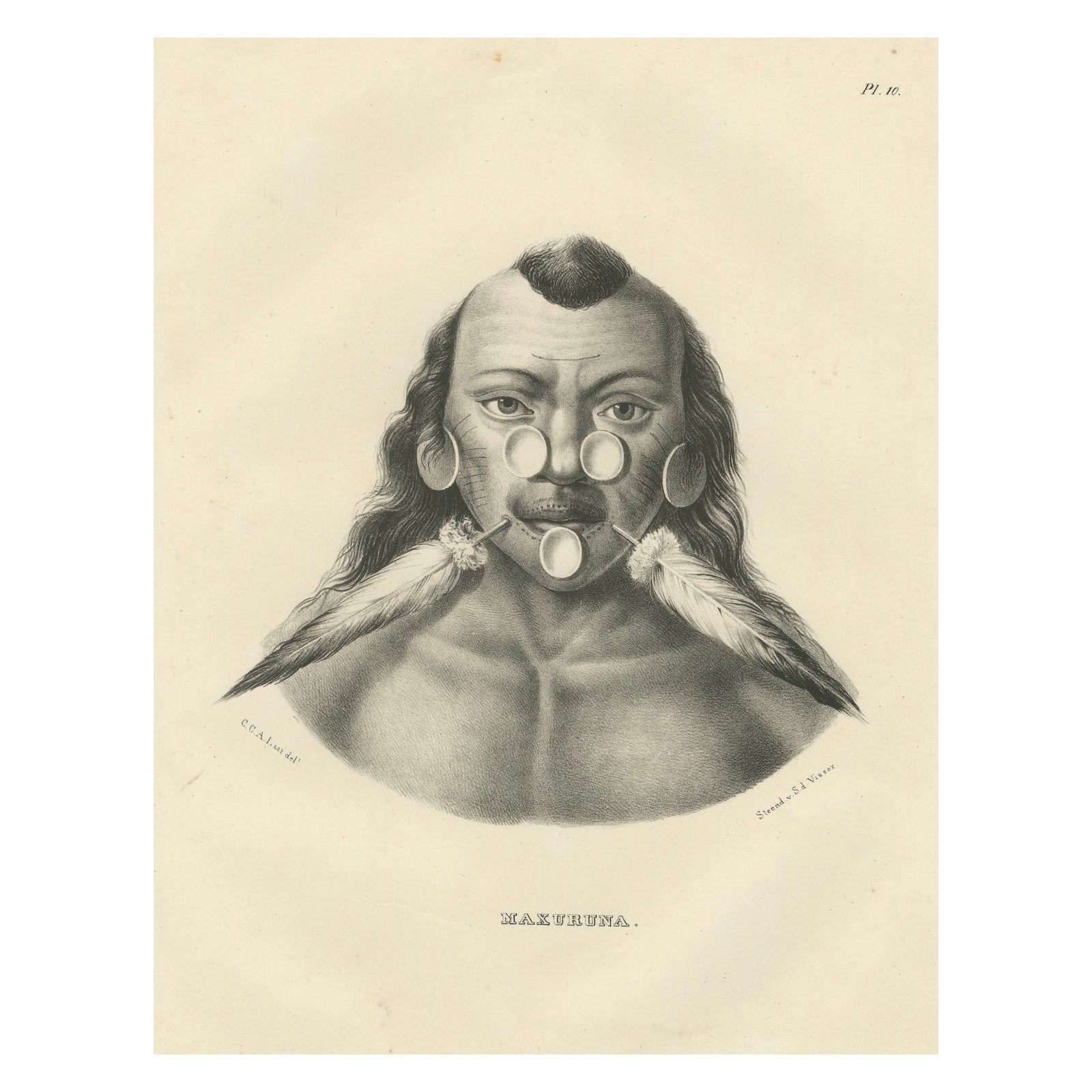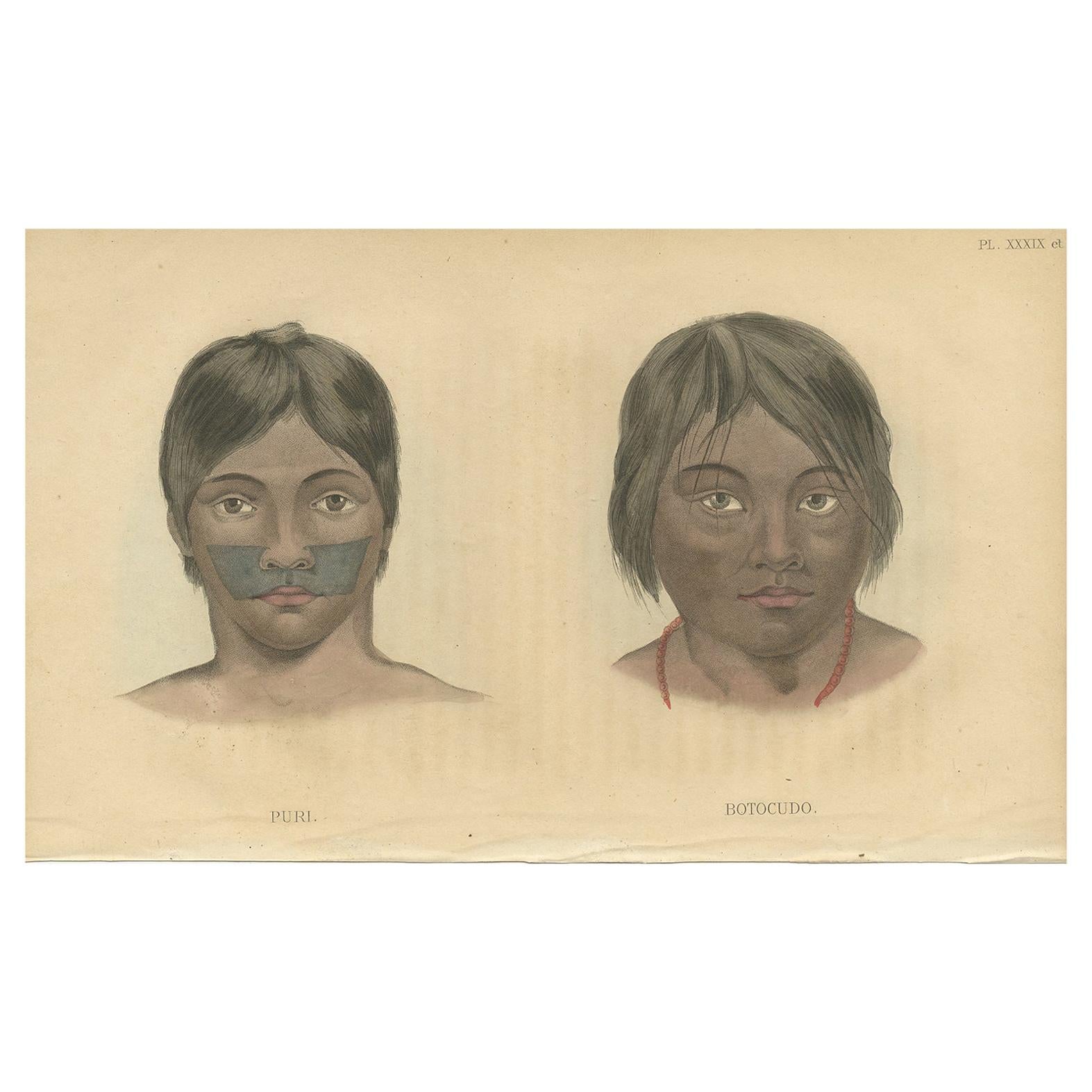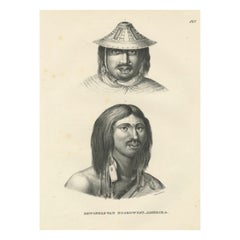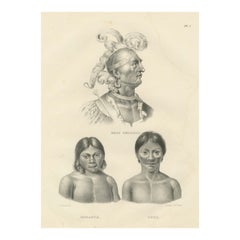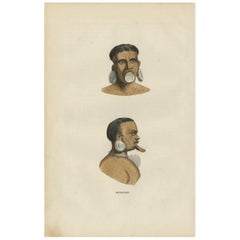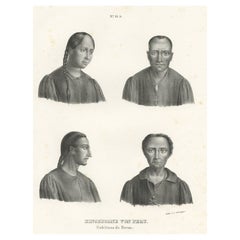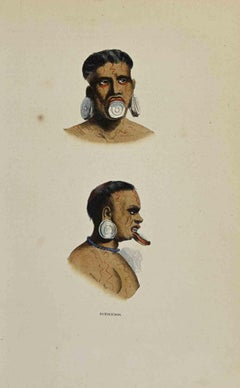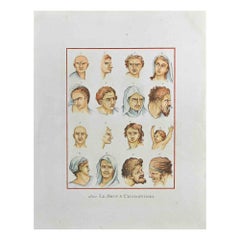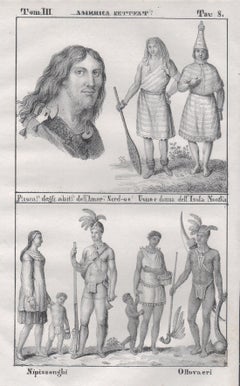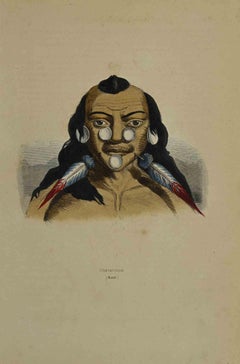Items Similar to Portraits of Botocudo People from South America by Karl Joseph Brodtmann, 1836
Want more images or videos?
Request additional images or videos from the seller
1 of 6
Portraits of Botocudo People from South America by Karl Joseph Brodtmann, 1836
$421.75
$527.1820% Off
£313.96
£392.4520% Off
€352
€44020% Off
CA$577.69
CA$722.1120% Off
A$642.51
A$803.1420% Off
CHF 335.50
CHF 419.3820% Off
MX$7,818.72
MX$9,773.4020% Off
NOK 4,284.86
NOK 5,356.0820% Off
SEK 4,018.44
SEK 5,023.0520% Off
DKK 2,679.65
DKK 3,349.5720% Off
Shipping
Retrieving quote...The 1stDibs Promise:
Authenticity Guarantee,
Money-Back Guarantee,
24-Hour Cancellation
About the Item
This lithograph by Karl Joseph Brodtmann depicts members of the Botocudo people, an indigenous group from Brazil. The Botocudo are historically known for their distinctive use of large lip and ear plugs, which are prominently featured in this illustration. The print likely dates from Brodtmann's 1835 series on ethnographic studies, aimed at documenting the physical and cultural characteristics of various indigenous peoples.
Description:
The lithograph shows four individual portraits of Botocudo people, each highlighting the prominent lip and ear plugs for which the group is known. These types of body modifications were a significant cultural practice among the Botocudo, who inhabited the interior forests of southeastern Brazil.
1. Top left and right figures: These two individuals are shown in profile and in partial frontal views. Both wear large lip and ear plugs, known as "botoques", made from wood or bone. Their hair is cut short, and their facial expressions are neutral. The exaggerated size of the lip plugs, particularly visible in these views, emphasizes the importance of this cultural practice. The men also have ear plugs of considerable size, suggesting their high rank or full participation in traditional Botocudo practices.
2. Bottom left and right figures: These two figures are also portrayed in profile views, similarly adorned with large lip and ear plugs. The profile perspective allows for a more detailed depiction of the way these plugs were inserted and worn. The posture and calm expressions of these individuals give them a dignified air, suggesting the importance of the practice as an integral part of their cultural identity.
The lithograph focuses entirely on the facial features and the characteristic adornments, with little background or clothing depicted, ensuring that the viewer's attention is directed to the lip and ear modifications.
Maker:
Karl Joseph Brodtmann (1787–1862) was a Swiss lithographer and illustrator known for his ethnographic and scientific works. His illustrations were often published in books and studies focused on anthropology and natural history, and they served to introduce European audiences to the customs and appearances of non-European peoples. His works were detailed, realistic, and focused on cultural markers that were deemed exotic or unusual at the time.
### Technique and Style:
This lithograph, like others by Brodtmann, uses **lithography**, a printmaking technique that allows for detailed, reproducible images. Brodtmann’s style is one of **ethnographic realism**, with a focus on accurately depicting the physical characteristics of his subjects. The shading in the lithograph adds depth to the figures, and the fine lines highlight the texture of the lip and ear plugs, as well as the skin and facial features of the individuals.
Brodtmann’s work reflects a European fascination with the cultural practices of indigenous peoples, particularly those practices that were seen as markedly different from European customs. The **botocudos**, with their large lip and ear plugs, became a symbol of cultural difference, and their portrayal in this lithograph would have intrigued 19th-century European viewers.
Cultural Context:
The Botocudo (or Aimoré) people were indigenous to southeastern Brazil. The name “Botocudo” was given by the Portuguese and refers to the botoques (plugs) that they wore in their lips and ears. These body modifications were an important part of Botocudo culture, likely symbolizing adulthood, status, or affiliation within the tribe.
During the 19th century, the Botocudo were subject to displacement and conflict with Portuguese colonizers, who attempted to control and assimilate indigenous populations. The Botocudo's resistance to European rule and their distinctive appearance made them a subject of curiosity in European ethnographic studies.
Botocudo, South American Indian people who lived in what is now the Brazilian state of Minas Gerais. They spoke a language of the Macro-Ge group. Their culture was similar to that of other nomadic tribes of the forests and mountains of eastern Brazil. Hunting bands of from 50 to 200 members were led by men considered most powerful in the supernatural realm. The Botocudo believed that spirits inhabited the sky and interceded in human affairs through the mediation of shamans, persons to whom were granted extraordinary powers. Interband conflicts were common, but these were usually resolved by duels between pairs of opponents using long sticks. Resistance to white expansion met with a policy of ruthless extermination. The few remaining Botocudo are descendants of those who took to agriculture and came to terms with the colonial advance.
This lithograph serves as both a document of their unique cultural practices and a reflection of European interest in non-Western peoples during the age of exploration and colonization.
- Dimensions:Height: 12.8 in (32.5 cm)Width: 10.24 in (26 cm)Depth: 0 in (0.02 mm)
- Materials and Techniques:
- Period:
- Date of Manufacture:1836
- Condition:Condition: good, given age. General age-related toning and/or occasional minor defects from handling. Some stains along the right border, not affecting the image. Please study scan carefully.
- Seller Location:Langweer, NL
- Reference Number:Seller: BG-13176-111stDibs: LU3054341515232
About the Seller
5.0
Recognized Seller
These prestigious sellers are industry leaders and represent the highest echelon for item quality and design.
Platinum Seller
Premium sellers with a 4.7+ rating and 24-hour response times
Established in 2009
1stDibs seller since 2017
2,510 sales on 1stDibs
Typical response time: <1 hour
- ShippingRetrieving quote...Shipping from: Langweer, Netherlands
- Return Policy
Authenticity Guarantee
In the unlikely event there’s an issue with an item’s authenticity, contact us within 1 year for a full refund. DetailsMoney-Back Guarantee
If your item is not as described, is damaged in transit, or does not arrive, contact us within 7 days for a full refund. Details24-Hour Cancellation
You have a 24-hour grace period in which to reconsider your purchase, with no questions asked.Vetted Professional Sellers
Our world-class sellers must adhere to strict standards for service and quality, maintaining the integrity of our listings.Price-Match Guarantee
If you find that a seller listed the same item for a lower price elsewhere, we’ll match it.Trusted Global Delivery
Our best-in-class carrier network provides specialized shipping options worldwide, including custom delivery.More From This Seller
View AllPortraits of Inhabitants of Northwest America by Karl Joseph Brodtmann, 1836
Located in Langweer, NL
This lithograph, by Karl Joseph Brodtmann, is labeled "Bewoners van Noordwest-Amerika" (Inhabitants of Northwest America). It depicts two individuals from indigenous groups likely li...
Category
Antique 1830s Prints
Materials
Paper
$345 Sale Price
34% Off
Portraits of Mico Chlucco, Miranda, and Juri by Karl Joseph Brodtmann, 1836
Located in Langweer, NL
This lithograph by Karl Joseph Brodtmann is one of his ethnographic works, featuring three portraits: Mico Chlucco, Miranda, and a Juri individual. The portrayal of these figures ref...
Category
Antique 1830s Prints
Materials
Paper
$421 Sale Price
20% Off
Antique Print of the Indigenous Botocudos of Brazil by H. Berghaus, 1855
Located in Langweer, NL
This print originates from the first volume of ‘De Volken van den Aardbodem (..)’ by dr. H. Berghaus. Published by G.B. van Goor, Gouda, 1855. Dutch edition.
Category
Antique Mid-19th Century Prints
Materials
Paper
$95 Sale Price
33% Off
Antique Print of Natives from Peru, South America, ca.1845
Located in Langweer, NL
Antique print titled 'Eingeborne von Peru, Habitans de Perou'. This print depicts natives from Peru, South America. Originates from 'Naturgeschichte und Abbildungen des Menschen der ...
Category
Antique 1840s Prints
Materials
Paper
$268 Sale Price
20% Off
Portrait of a Member of the Maxuruna Amazon Tribe by Karl Joseph Brodtmann, 1836
Located in Langweer, NL
This lithograph, created by Karl Joseph Brodtmann, depicts an individual named Maxuruna, who appears to belong to an indigenous group, from South America, based on the adornments and...
Category
Antique 1830s Prints
Materials
Paper
$354 Sale Price
32% Off
Antique Print of People of the Puri and Botocudo Tribe by Prichard, 1843
Located in Langweer, NL
Antique print titled 'Puri - Botocudo'. Lithograph of people of the Puri and Botocudo tribe. This print originates from 'Histoire Naturelle de l’Homme Comprenant des recherches sur L...
Category
Antique Mid-19th Century Prints
Materials
Paper
$95 Sale Price
20% Off
You May Also Like
Botocudos - Lithograph by Auguste Wahlen - 1844
Located in Roma, IT
Botocudos is a hand colored lithographs realized by Auguste Wahlen in 1844.
Good conditions.
The artwork belongs to the Suite Moeurs, usages et costumes de tous les peuples du mond...
Category
1840s Modern Figurative Prints
Materials
Lithograph
Portraits - The Physiognomy - Etching by Thomas Holloway - 1810
By Thomas Holloway
Located in Roma, IT
Portraits is an etching realized by Thomas Holloway for Johann Caspar Lavater's "Essays on Physiognomy, Designed to Promote the Knowledge and the Love of Mankind", London, Bensley, ...
Category
1810s Modern Figurative Prints
Materials
Etching
Indigenous People, North America, mid 19th century lithograph.
Located in Melbourne, Victoria
'Fisom degli abiti dell' America Nord-oe / Uomo donna dell' Isola Nootka' / 'Nipissonghi / Ottovaeri'
Italian lithograph, c1841. Originally from 'Galleria universale di tutti i popo...
Category
Mid-19th Century Naturalistic Figurative Prints
Materials
Lithograph
Maxourounas - Lithograph by Auguste Wahlen - 1844
Located in Roma, IT
Maxourounas is a hand colored lithographs realized by Auguste Wahlen in 1844.
Good conditions.
The artwork belongs to the Suite Moeurs, usages et cost...
Category
1840s Modern Figurative Prints
Materials
Lithograph
Caribbean Indigenous People / Orinoco, America, mid 19th century lithograph.
Located in Melbourne, Victoria
'Famiglia di Karaibi' / 'Tartarnughe deponenti le uova alle sponde dell' Orenoko''
Italian lithograph, c1841. Originally from 'Galleria universale di tutti i popoli del mondo' by Gi...
Category
Mid-19th Century Naturalistic Figurative Prints
Materials
Lithograph
New Zealand Inhabitants - Lithograph by Auguste Wahlen - 1844
Located in Roma, IT
New Zealand Inhabitants is a hand colored lithograph realized by Auguste Wahlen in 1844.
Good conditions.
The artwork belongsto the Suite Moeurs, usages et costumes de tous les peu...
Category
1840s Modern Figurative Prints
Materials
Lithograph
More Ways To Browse
Dovetail Vinyl Record
Dragon Boat
Egyptian Cat
Embossed Copper Box
English Bow Front Chest
English Headboard
English Iron Bed
Folding Travel Clock
Fornasetti Paper
Four Poster Bed Kings
Francois Pompon
Franz Xavier Bergman
Frem Rojle Chair
French Confit Jar
French Opaline Bottle
French Soda
Garden Rabbit
German Cigarette Case
